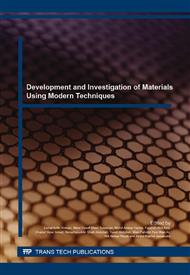[1]
X. Liu, P.K. Chu, and C. Ding, Surface modification of titanium, titanium alloys, and related materials for biomedical applications, Mater. Sci. Eng. R. 47 (2004) 49-121.
DOI: 10.1016/j.mser.2004.11.001
Google Scholar
[2]
M.A. Selimin, N.H.M. Idrus, and H.Z. Abdullah, Anodic oxidation of titanium for biomedical application, Adv. Mater. Res. 1087 (2015) 81-85.
DOI: 10.4028/www.scientific.net/amr.1087.81
Google Scholar
[3]
K.J. Tan, H.Z. Abdullah, M.I. Idris, and C.C. Sorrell, Gel oxidation of titanium at low concentration of sodium hydroxide (NaOH), Adv. Mater. Res. 1087 (2015) 340-344.
DOI: 10.4028/www.scientific.net/amr.1087.340
Google Scholar
[4]
L.L. Hench, Bioceramics: From concept to clinic, J. Amer. Ceram. Soc. 74, (1991) 1487-1510.
Google Scholar
[5]
M.F. Brunella, M.V. Diamanti, M.O. Pedeferri, F. Di Fonzo, C.S. Casari, and A. Li Bassi, Photocatalytic behaviour of different titanium dioxide layers, Thin Solid Films. 515 (2007) 6309-6313.
DOI: 10.1016/j.tsf.2006.11.194
Google Scholar
[6]
T. Dikici, M. Erol, M. Toparli, and E. Celik, Characterization and photocatalytic properties of nanoporous titanium dioxide layer fabricated on pure titanium substrates by the anodic oxidation process, Ceram. Int. 40 (2014) 1587-1591.
DOI: 10.1016/j.ceramint.2013.07.046
Google Scholar
[7]
N. Ohtsu, H. Kanno, S. Komiya, Y. Mizukoshi, and N. Masahashi, Fabrication of visible-light-responsive titanium dioxide layer on titanium using anodic oxidization in nitric acid, Appl. Surf. Sci. 270 (2013) 513-518.
DOI: 10.1016/j.apsusc.2013.01.071
Google Scholar
[8]
Z. Li, J. Li, B. Huang, X. Wu, W. Qiao, X. Luo, and Z. Chen, Ultraviolet irradiation enhanced bioactivity and biological response of mesenchymal stem cells on micro-arc oxidized titanium surfaces, Dent. Mater. Journal, (2015) 1-13.
DOI: 10.4012/dmj.2014-125
Google Scholar
[9]
B. Li, Y. Li, J. Li, X. Fu, C. Li, H. Wang, S. Liu, L. Guo, S. Xin, C. Liang, and H. Li, Improvement of biological properties of titanium by anodic oxidation and ultraviolet irradiation, Appl. Surf. Sci. 307 (2014) 202-208.
DOI: 10.1016/j.apsusc.2014.04.015
Google Scholar
[10]
K. Uetsuki, H. Kaneda, Y. Shirosaki. S. Hayakawa, A. Osaka, Effects of UV-irradiation on in vitro apatite-forming ability of TiO2 layers, Mater. Sci. Eng. B. 173 (2010) 213-215.
DOI: 10.1016/j.mseb.2009.11.013
Google Scholar
[11]
H.J. Song, S.H. Park, S.H. Jeong, and Y.J. Park, Surface characteristics and bioactivity of oxide films formed by anodic spark oxidation on titanium in different electrolytes, Mater. Process. Technol. 209 (2009) 864-870.
DOI: 10.1016/j.jmatprotec.2008.02.055
Google Scholar
[12]
Y. Mizukoshi, and N. Masahashi, Fabrication of a TiO2 photocatalyst by anodic oxidation of Ti in a sulphuric acid electrolyte, Surf. Coat. Technol. 240 (2014) 226-232.
DOI: 10.1016/j.surfcoat.2013.12.030
Google Scholar
[13]
H.Z. Abdullah, and C.C. Sorrell, Gel oxidation of titanium and effect of UV irradiation on precipitation of hydroxyapatite from simulated body fluid, Adv. Mater. Res. 488-489 (2012) 1229-1237.
DOI: 10.4028/www.scientific.net/amr.488-489.1229
Google Scholar
[14]
Y.T. Sul, C.B. Johansson, Y. Jeong, and T. Albrektsson, The electrochemical oxide growth behaviour on titanium in acid and alkaline electrolytes, Med. Eng. Phys. 233 (2001) 29-346.
DOI: 10.1016/s1350-4533(01)00050-9
Google Scholar
[15]
D. Regonini, C.R. Bowen, A. Jaroenworaluck, and R. Stevens, A review of growth mechanism, structure nd rystallinity of anodized TiO2 nanotubes, Mater. Sci. Eng. R. 74 (2013) 377-406.
DOI: 10.1016/j.mser.2013.10.001
Google Scholar
[16]
H. Ishizawa, and M. Ogino, Formation and characterization of anodic titanium oxide fimls containing Ca and P, Biomed. Mater. Res. 29 (1995) 65-72.
DOI: 10.1002/jbm.820290110
Google Scholar


